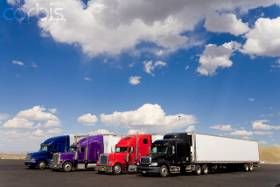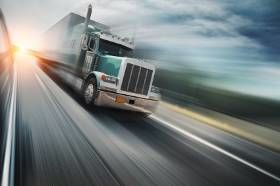First Time Driving Semi's - Can't Recall 'what The Minimum & Maximum Rpm' For The Truck Engine? Is It 0-5000rpm?
Topic 4712 | Page 1

Welcome Karen. I'm a complete newbie to the industry but what I've learned in the school that I've attended is that it will vary per type of truck. I mostly trained on double clutching. We were instructed the magic #'s for shifting were 10-1100 and 17-1900. A graduated student informed me that the truck he is in the #'s are lower. I think if I were asked the question I would say it depends on the truck.
If you don't hear another reply to this post I would recommend posting on the General Discussion forum as many more folks will see it and be likely to offer suggestions.
Double Clutch:
To engage and then disengage the clutch twice for every gear change.
When double clutching you will push in the clutch, take the gearshift out of gear, release the clutch, press the clutch in again, shift the gearshift into the next gear, then release the clutch.
This is done on standard transmissions which do not have synchronizers in them, like those found in almost all Class A trucks.
Double Clutching:
To engage and then disengage the clutch twice for every gear change.
When double clutching you will push in the clutch, take the gearshift out of gear, release the clutch, press the clutch in again, shift the gearshift into the next gear, then release the clutch.
This is done on standard transmissions which do not have synchronizers in them, like those found in almost all Class A trucks.

EVERY TRUCK IS DIFFERENT !!!!! The shifting rpms are dependent on a few things.....The engine size....the transmission....the rear end gears....how heavy the load is....AND the terrain you are on. If I have a Peterbuilt (heavy truck, btw) that has a puny Detroit 60 series in it, thats old and tired, with a 15 speed transmission, and long legged 370 rear gears (great for speed, bad for hills), a load that tops me at 80,000 pounds, and I'm headed up a hill....I'm gonna be downshifting like mad. Starting out with that same truck...I'll be using ALL 15 gears, and wishing I had more motor and more gears. But....if I had that same truck with a nice light 30,000 load on, I'd skip the first 3 gears, and probably a few more to get up to speed. ( learned to drive OTR in the truck I just described) So its not HOW you drive....its WHAT you drive, HOW your loaded, WHERE you are on the road..... And personally...it sounds like the guys are just tryin to pressure you out of your job....tell 'em to go grow a pair.. It doesn't take "outside plumbing" to drive truck. They are welcome to come on over here, where we have REAL mountains, and I'll scare the hair off of any place on their bodies..and if they want to bash a woman, try pickin' on their wife, and see what that gets them for dinner...........knuckle draggers....I hate 'em.
OTR:
Over The Road
OTR driving normally means you'll be hauling freight to various customers throughout your company's hauling region. It often entails being gone from home for two to three weeks at a time.

Hi Karen and welcome!
I am also a student who was taught to double clutch. I agree with B&B that each truck is different and you may want to post on the general forum too.
In my school, we were taught that the optimum driving range is btwn 1100-1600 rpms. When down shifting 1 gear, rpms should be btwn 700- 900 and btwn 600-700 rpm if you are downshifting two gears. Listen to that engine (it will tell you when you need to change gears), glance at the tach, shift, and keep it moving. You will get the hang of it soon enough. There is ALWAYS a learning curve when it comes to something that you are not used to.
If your boss has taken you under his wing, I advise that you ask him. Clearly, he saw something in you or else he would not have hired you! As for those other guys........forget them. Do they pay you? My grandma always said that sometimes people with the most insecurities were the ones yapping the most about nothing. It takes a REAL human being to help/assist another human being! Put your head up, ask question from the source and work it girl! Cole
https://www.youtube.com/watch?v=em328ua_Lo8
Double Clutch:
To engage and then disengage the clutch twice for every gear change.
When double clutching you will push in the clutch, take the gearshift out of gear, release the clutch, press the clutch in again, shift the gearshift into the next gear, then release the clutch.
This is done on standard transmissions which do not have synchronizers in them, like those found in almost all Class A trucks.
Dm:
Dispatcher, Fleet Manager, Driver Manager
The primary person a driver communicates with at his/her company. A dispatcher can play many roles, depending on the company's structure. Dispatchers may assign freight, file requests for home time, relay messages between the driver and management, inform customer service of any delays, change appointment times, and report information to the load planners.HOS:
Hours Of Service
HOS refers to the logbook hours of service regulations.New Reply:
New! Check out our help videos for a better understanding of our forum features

















Preview:








 TT On Facebook
TT On Facebook
Or am I getting that confused with something else?
Hi all, I live in Australia and am 40yrs old. I changed careers 3 years ago and decided I wanted to drive trucks. Drove 6-8 tonners for last 3 years then got MC licence so i could drive the big rigs.
I've just started a new job with only small truck experience, no semi experience, which the boss has taken me under his wing to help me get experience etc. However the men in the company question me constantly about the engine etc and state that I should know all these things. I feel that these guys forget they had to start somewhere and didn't know everything and possibly still don't, even after all the years they have been driving.
Just want a chance to learn, not be criticized for it and just because I'm a women doesn't mean I'm not capable.
Please help!!!!